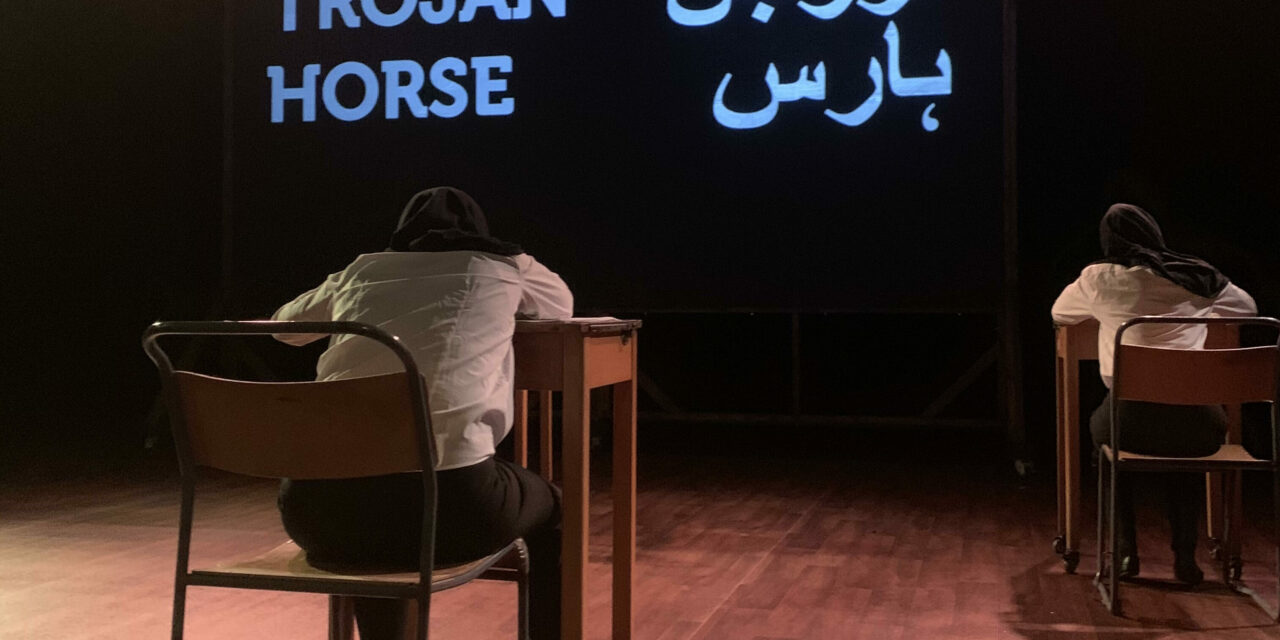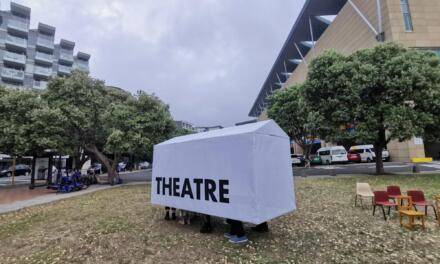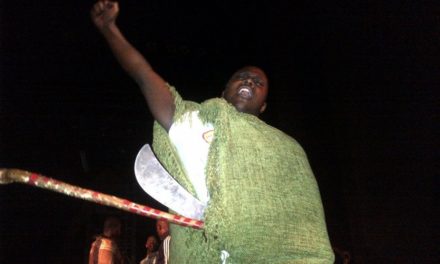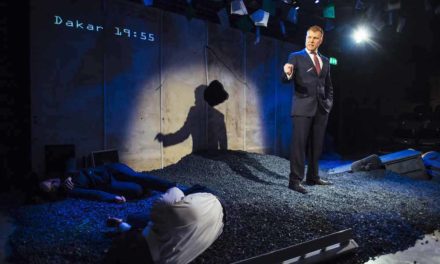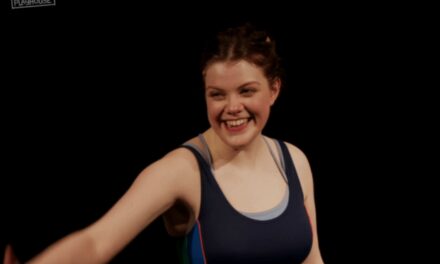In 2019, Ayesha Manazir Siddiqi was asked to translate Trojan Horse, a play by Lung Theatre based on the ‘Trojan Horse’ affair that brought a number of Birmingham schools to the attention of the media in 2014 over the alleged radicalization of their students. In this personal response to the piece, she explores here the complex and contradictory feelings that arose as she set about translating the text into Urdu.
‘tell me about your pain. I want to know your story. And then I will tell it back to you in a new way. Tell it back to you in such a way that it has become mine, my own. Re-writing you, I write myself anew. I am still author, authority. I am still the colonizer, the speaking subject’ – bell hooks
Trojan Horse, a play by Helen Monks and Matt Woodhead, is being published this autumn, in both English and Urdu, and touring the country, reaching London in November 2019. As Urdu translator of the play, I developed complex and contradictory feelings on how to work with a piece that I felt fundamentally and increasingly unaligned with.
The play is about the Trojan Horse affair in Birmingham, where in 2014, a letter was leaked to the press; it appeared to be from one Muslim parent to another, praising a supposed plan by Muslim directors to impose a strict Islamic ethos in several schools in Birmingham. The letter turned out to be a hoax, but the media frenzy that followed it – panic about children being ‘radicalized’, torn away by ‘Islamic extremism’ from ‘fundamental British values’ – revealed the deeply Islamophobic racist undercurrent running through British society. At the same time, the allegations in the letter triggered an Ofsted investigation into the schools, which found evidence of some of the directors and teachers of the schools holding homophobic and misogynistic views, of pupil segregation, of the infusing of Islamic teaching into lessons, and of priority being given to core subjects like English and Math over drama and music. Some of these claims – the Islamic teachings, the segregation – are contested; others – the homophobic views, albeit held privately – are accepted by all involved. A case was conducted against the school teachers, but it eventually collapsed, because of a mishandling of evidence by the prosecution. The incident remains a deeply controversial one, that continues to divide people today.
The call for the translation came through a translators’ network, and I was initially sent an extract of five pages from near the end of the piece. The names of the writers were not included in this extract, but the gap between themselves and the people they were representing was apparent straight away. For one thing, some of the Pakistani names didn’t sound like real Pakistani names, just sort of ‘Pakistani-ish’. I raised the query about the made-up names, which were subsequently changed to more realistic ones, which I suggested.
The content of the work also left me feeling uncomfortable. Trojan Horse follows Farah, a young student, and Rashid, a teacher, and director, as they navigate the leak of the hoax letter, the media hype and investigative intrusion, and then the aftermath of the incident. Farah is a troubled teenager; she comes from a difficult family background, and school for her is a solace. The first thing she tells us in the play is that her father pressurizes her to wear a hijab.
In this, the writers show the same fascination with the hijab that they go on to accuse the Trojan Horse investigative team of showing. And even more damningly, they set up a dangerous dichotomy right from the start. The school and its teacher, Rashid, become places of refuge from a violent, crowded home where the hijab is forced on Farah. Rashid, similarly, comes from a troubled background, with petty crime and violence, absent parents, an ‘extremist’ brother, and so on. This has the effect of turning the school into a strange, mythical place where the protagonists escape their oppressive home cultures. The entire set-up begins to seem odd; a story where a grave injustice genuinely took place is told in such simplistic binaries that it starts to appear suspect. In the sample I was sent, Rashid, the teacher, says that, unlike his terrorist brother, moderate Muslims like him are exactly what the educational system needs. ‘Just look at my brother,’ he says, ‘you need people like me to educate and guide kids to follow the right path’. These words immediately set up a dichotomy between the good Muslim that he represents and the bad Muslim that his brother represents. This happens repeatedly in the play, for instance, with Farah’s father, homophobic, violent and invisible, and all the other people and institutions used as foils for the ‘good’ Muslim people and the ‘good’ Muslim schools in the play. The dichotomy absolves them in the play by showing how they were not extremists, as opposed to the real extremists, lurking in the shadows of the text. It is a profoundly dangerous and simplistic logic, and it is at the core of the work.
This sample of five pages also contained Jess, a well-meaning white leftist character, proclaiming, ‘not in my name,’ and Farah, the Pakistani student, saying ‘British values? What the hell are they? British values are Islamic values.’ These tropes, peddled robotically by many of the liberal left when they think they’re fighting against Muslim prejudice, are in fact, only entrenching prejudices more deeply into the national consciousness. Jess’s ‘not in my name’ absolves the well-meaning left, reducing the problem to the obviously racist characters in the work. White liberals can leave this play washed clean of their sins, feeling glad that they are not like the stupid racists who backed the scandal, that they’re the good ones. And Farah, with her equivalence of British values and Islamic values, performs the age-old trope of ‘I am just like you, and therefore you can like me’. This trope, evoking assimilation as a requirement for tolerance and acceptance, again, contradicts the very argument it tries to make. ‘We’re all wired the same way,’ Rashid says in the very next passage, reinforcing once more that same logic. Of course, on some level, we are all wired the same way, but the moment this is used as a plea for tolerance, it’s also saying that difference is unacceptable. When writers, more and more, complain about the representation of people of colour (PoC) by non-PoC, this is what they’re talking about. They’re not talking in abstract terms; they’re not saying, ‘only write what you know’, or even more ridiculously, demanding a curtailment of anybody’s freedom of expression. What they are protesting against is the type of simplistic and therefore, dishonest, storytelling that this play evidences. The white lens through which the Trojan Horse hoax is seen is palpable in the play, and this can be profoundly damaging, even if well-meaning.
In projecting this good/bad dichotomy, Trojan Horse strips the story of layers to the degree that it sometimes ends up sounding nonsensical. We see this when Rashid apologizes for homophobic texts that he had sent a year earlier, in repentance of views he says he no longer espouses. He does this in a practice run with his lawyer, leaving it sounding, frankly, as if he is doing this for the benefit of the tribunal (an understandable move). This muddies the argument, which is actually very clear, that an injustice has taken place. His words may, of course, be genuine; one of the teachers that Samira Shackle interviews in her brilliant long-form essay in The Guardian on the Trojan Horse affair does, indeed, feel this way. But it may also have been created from the stitching together of the words of two different people to form one character. The writers frequently employed this device in their story-telling, combining more than one character into one. This merging sometimes results in murky plot lines and unconvincing characters. One or two of these inconsistencies were flagged by me and removed. Others, some subtle, some overt, are still there, adding to the confusing, disjointed nature of the work, of the story it is trying to get across.
Whatever the case is regarding the homophobic texts, the tackling of the issue of homophobia in the Pakistani community in this play is not just clumsy, it is also dangerous. Farah says, at one point,
‘How can my dad understand when there isn’t like a word for it? In the like Qur’an – there isn’t a word for gay. The only mention of same-sex relationships is sodomy? … the only word that explains who I am, is a word that means violence and shame.’
I can safely say, as a translator to the text, that there is a word for gay in Urdu, the language Farah’s father presumably speaks, but also, he would probably understand the English word gay. The logic of this speech is convoluted and dangerous, tying up homophobia directly to the Quran, and then taking the next step of therefore tying it into a culture. Farah’s dad, who slaps her if she hasn’t done the washing up, is portrayed as the very ‘Islamic extremist’ that the play berates the media for conjuring.
Let’s be clear. Homophobia and, for that matter, anti-blackness, and patriarchal oppression in South Asian communities are serious problems and need attention. This is being talked about every day in PoC activist circles, amongst people determined to dismantle systemic oppression. It is also tackled, or not, in the places it occurs. However, the problem with speaking in the mainstream about homophobia in the Muslim community is that the moment the issue is raised, it is instrumentalized and co-opted into a racist and Islamophobic agenda. This may be conscious, or not. But it becomes about saving the poor Muslims from their backward and violent thinking. This is what happens in this play, despite its best intentions. This is also what happened in the implementation of the LGBT education program No Outsiders, which was rolled out to several Muslim schools in Birmingham. Such programs, paternalistic and presumptuous, don’t come from a place of love or engagement; they come from a kind of colonial thinking, a Prevent-style attempt to control and enforce. An act of love and engagement, in the case of this play, would have been if the writers had looked within, if they had thought about their own privilege and whiteness and what part that plays in the way the world is today. To externalize the problem into the evil racists on the one side and the evil extremists on the other, in order to exonerate the school and the Trojan Horse participants and frankly, themselves, is disingenuous.
The reason the play stands on such shaky ground is that it has chosen to use the very same framework that was used to condemn the Trojan Horse players in order to exonerate them. It says, look, these Muslims were innocent, as opposed to the homophobic father, as opposed to the extremist brother, as opposed to the other school, Al-Furqan, which does privilege faith over academic success. There is, throughout, a taking for granted of the white supremacist parameters that framed the Trojan Horse affair. This can only collapse in on itself. A dismantling of the very framework of white supremacy is required in order to treat this story with the respect it needs.
I found myself playing a strange role in this work, somewhere between translator and consultant, when I pointed out the obvious inconsistencies. The writers seemed very attentive to my feedback, eager that I point out anything that may be offensive or inappropriate, ready to change it without question. However, this is not the solution; this is just smoothing over of surface imperfections to create an image of political correctness. In fact, in this smoothing-over of obvious blunders, I became complicit, making the piece seem more acceptable, leaving room for more subtle, insidious misrepresentations to flourish. I found myself imagining what this play would have looked like if it had been made by a Pakistani Muslim from Birmingham for other Pakistani Muslims from Birmingham; the radical potential of that kind of play. What, in fact, would this play have looked like if it had been written by an Urdu speaker, and I had been approached to translate it into English? When will room be made in the industry for that play?
It is important to note here that Trojan Horse is based on interviews; the people it portrays are the people who were there, and those people, as far as I know, like the play. They are happy with their representations and hope that the play will bring justice to those who were falsely accused. The writers and supporters of the play also hold an intention, deeply and earnestly, for justice for those whose careers and reputations were destroyed by the fear-mongering, by the racist assumptions. The plight of the accused genuinely resonated with the writers, the injustice was deeply felt by them. The foreword to the book, written by Baroness Sayeeda Warsi, praises the play and decries the Islamophobia that created Trojan Horse and that is still prevalent today. The theatre company that produced the play, Lung, founded in 2012 by the playwrights themselves when they were at university, calls itself ‘a verbatim and documentary touring theatre company who make work with communities, for communities, and about communities’. Putting aside the patronizing undertones of ‘communities’, this does evoke a question: if the play is approved of by those whom the writers say it is for and about, how can I claim that it is problematic? Furthermore, if there are well-meaning intentions, including the pursuit of justice, and a possibility of actual change, should the project be judged so harshly?
The truth is, in spite of well-meaning intent, in spite of feedback from those involved, the play needs to be judged as a stand-alone piece; it needs to be critiqued on its own merit, or lack thereof. Also, importantly, a few words on the testimony-based play: a testimony based play is not an unbiased play. The testimony received is deeply influenced by the person receiving it. It is unlikely that ‘Muslim values are British values’ or ‘we are all wired the same way’ would have come up if the testimony were being given from one Muslim to another. The expository dialogues about homophobia or the treatment of women in Islam would probably not have come up either. The discourse would have been far more nuanced and exploratory. The questions themselves would have been different. The age, the whiteness, the politics, the agenda, the lived experiences of the questioners are necessarily infused into the questions they ask and the answers that they receive. Then, there is a heavy editorial hand. What is put in, and what is left out is, of course, agenda-driven; the testimony is used to shape a story.
The time has ended for this style of anthropological storytelling, particularly that conducted without careful deliberation on the ethics of the encounter and a deep political understanding of the nuanced politics of the subject matter. In an interview with WhatsOnStage, one of the writers, Monks, says of their stories, “We don’t ever sit down and think theoretically about it … we’re just really focused on the story we’re telling and how to tell it best.” The story is, in fact, somebody else’s, and to tell somebody else’s story is a responsibility that should be thought about carefully. Listening to the real stories of pain and suffering, the stories that probably implicate people like the writers themselves is not easy; those are difficult stories to hear. What is easier is this story, a story with the good Muslims as victims and the racists as perpetrators: the perfect recipe for the assuagement of white guilt. A solution to this lack of depth in the ‘Muslim stories’ we see on stage can only begin with an honest appraisal of who the gatekeepers are in the theatre industry, what plays are supported, commissioned, demanded.
This is not to discount the importance of testimony, and the part that it can play in the transformation of trauma. The poems of Adrienne Rich, Lucille Clifton, and Amrita Pritam are a powerful testament to this. Yet, we must remain vigilant when testimonies are being appropriated or instrumentalized. Maya Angelou, referring to the pain of growing up as a black girl in the South in America said, ‘When I reach for the pen to write, I have to scrape it against those scars.’ Hers is the kind of testimonial writing that moves, that affects change. Trojan Horse is simply a case of its writers dancing (clumsily) across someone else’s scars.
The writers’ lack of lived experience in the trauma with which they deal is perhaps most obvious in the unqualified racist rhetoric that peppers the play. Elaine, for instance, says at one point,
‘we can’t just say to all the Pakistani Muslims in Birmingham, here, do what you want with your education system. Because if you went to a village in Kashmir which half of the population wouldn’t even go to school in the first place? It’s the girls!’
The reproduction of this kind of rhetoric is not providing balance or telling the whole story; it is simply providing a platform for racist views. I can’t imagine any Pakistani audience member not cringing when Elaine says these words on stage. And these views aren’t subsequently argued against or rebutted; they’re just left hanging there, a bit of poison, carelessly exposed, a result, simply, of the writers’ lack of embodied experience of that kind of speech.
Some of the play, however, may prove to be revelatory, and educational. It brings to the surface aspects of the affair that the public may not know: that information was withheld by the prosecution, that many actors in the investigation had their own vested interest, that verdicts were changed even though no additional evidence had been acquired, that the state and the investigators were being led, not by solid evidence, but by their own Islamophobic prejudices and political interests. This information, in a nation where many may not even have registered that the Trojan Horse letter turned out to be a hoax, is invaluable, and this is where the strength of the play lies. This is where the play’s search for justice and its pursuit of truth shines strongly. In the midst of this critique, that light must nonetheless be acknowledged. This is where the text becomes important; it tries to show, through a creative lens, facts that are otherwise dry, easy to miss. The excellent afterword by John Holmwood also delves into the nuances of the matter, with care and compassion.
Early on in the process, I sat with the playwrights to discuss preliminaries. I found myself, in the course of this meeting, squirming in discomfort at a throwaway comment, the way many Muslims have probably squirmed if they’ve had the bad luck to be caught up in a conversation about Islamophobic racism between a small group of white people. In that moment, I found myself going a bit quiet, turning inwards, listening from a distance; I had switched to writer mode. The palpable discomfort arose again, more recently, when I was sent proofs of the text. The cover of the published text is of a young Muslim schoolgirl, whose uniform and headscarf are being pulled at by several disembodied hands. The hands match the dark skin tone of the girl herself. And across the girl’s forehead is my name: translator: Ayesha Manazir Siddiqi.
There was a heart-wrenching contradiction at play here, of my affection for these, truly, quite lovely writers and a dedication to producing a good translation, versus a palpable discomfort with the alliance. My decision, which arose after several soul-searching conversations with some writer/activist friends, was to translate the piece and to critique it.‘The translation will exist either way,’ a friend said, ‘might as well be you. At least you can write about it.’ Still, the matter felt morally complex, it still does. To clear up some of my internal ambivalence, I told the writers of my feelings. They received my feedback with grace and generosity. Soon after, a clause was added to my contract that they were to review any work I wrote about the translation process before publication. I still feel somewhat confident, or at least hopeful, that my words will be received in a healthy way, and that I too have reflected their grace and generosity back. There are compassion and love at the heart of this dialogue, as just the act of dialogue, even challenging dialogue, implies a desire to connect. In every protest, there is despair, but also hope.
The desire to connect across differences is also what fuels translations. And in spite of my reservations, I found myself pouring every inch of myself into the translation, grappling over every dash and comma, wanting to do justice to every word. Ultimately, I created something I am proud of. This makes me think about the politics and ethics, the art and contradictions, of translation itself, the ways in which translators, too often invisibilized, produce art that is both of and independent to the piece.
The play, above all, reminded me of the urgency of meaningful stories about PoC, by PoC. The one-dimensional ventriloquistic representations of black, brown and East-Asian characters by white writers needs to give way to deep stories, uncomfortable stories even, where instead of the liberal elite congratulating itself on its wokeness, we all take a long look in the mirror and see how we ourselves are embedded in this hetero-normative, white supremacist, capitalist patriarchy. We all carry this, in our bones. One way of taking responsibility is by asking if somebody else should be speaking instead of ourselves. Another is by looking within, and allowing the quieter voices to speak: the scared ones, the sad ones, the angry ones, the ones who have had enough. This doesn’t mean interviewing the other; it means letting them have the pen, and taking up our own.
Ayesha Manazir Siddiqi is a writer and translator. Her reviews and essays have appeared in the Independent, Media Diversified, the Express Tribune, Wasafiri, and other publications. Her plays have had rehearsed readings in London, Derby, and Birmingham, and her fiction has been published in anthologies by Peepal Tree Press and Oberon books. She’s interested in an intersectional engagement with structural oppressions. Ayesha is from Karachi, and lives in London.
This post was written by the author in their personal capacity.The opinions expressed in this article are the author’s own and do not reflect the view of The Theatre Times, their staff or collaborators.
This post was written by Ayesha Manazir Siddiqi.
The views expressed here belong to the author and do not necessarily reflect our views and opinions.

